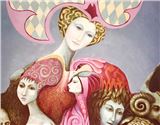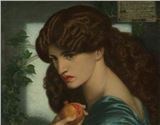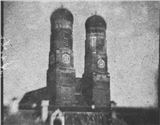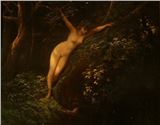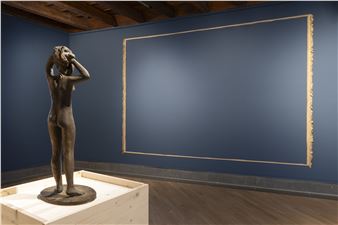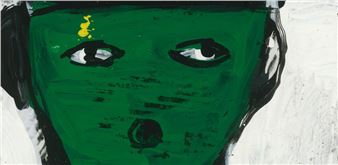The Permanent Collection: What the Bat Knows
Some stories live a different life in the dark. Many of us will have intimate knowledge of how storytelling is shaped by a narrator’s awareness of their audience. Whether offered as a teaching under the stars, a fixture of childhood bedtime rituals, or experienced collectively as theatre, stories told in the dark benefit from a listener’s ability to imagine an unfamiliar elsewhere in the shadows. In these spaces we trust that the bedroom is also a vessel, the theatre a cave, and the sky an archive.
The third in a series of yearlong permanent collection exhibitions, What the Bat Knows is an experimental exhibition that reflects on how other voices – perhaps inhuman voices –can function as subversive narrators within a museum. Drawing from examples of speculative fiction that seek new models for understanding experience and perception, this exhibition will unfold in three phases, each finding a unique narrator in a trio of porcelain bat sculptures by multi-disciplinary artist Shary Boyle. The first phase of the exhibition will explore the theme of invisible networks with an emphasis on ecologies wherein humans are not placed at the centre. In the second phase, works such as George Hunter’s documentation of mining operations hint at the more extractive aspects of human industry that proliferate underground. Theories of an elsewhere – be that a hypothetical afterlife or the terrain of dreams – are introduced in the exhibition’s final phase through Liz Magor’s uncanny sculpture and Leland Bell’s painting wherein a void, an ocean floor, and a night sky appear to be one and the same.
If we were to think of how narration takes shape within an exhibition, we might naturally assign that role to the artist or the curator. But what if a narrator isn’t human? Can an individual work in an exhibition perform this role? What information can we trust them to share and what do we stand to learn through their ignorance or worse, purposeful omission? What the Bat Knows invites visitors to consider how a museum collection is much like a slow-moving narrative – one that is capable of reinvention with each retelling.

Recommended for you
Some stories live a different life in the dark. Many of us will have intimate knowledge of how storytelling is shaped by a narrator’s awareness of their audience. Whether offered as a teaching under the stars, a fixture of childhood bedtime rituals, or experienced collectively as theatre, stories told in the dark benefit from a listener’s ability to imagine an unfamiliar elsewhere in the shadows. In these spaces we trust that the bedroom is also a vessel, the theatre a cave, and the sky an archive.
The third in a series of yearlong permanent collection exhibitions, What the Bat Knows is an experimental exhibition that reflects on how other voices – perhaps inhuman voices –can function as subversive narrators within a museum. Drawing from examples of speculative fiction that seek new models for understanding experience and perception, this exhibition will unfold in three phases, each finding a unique narrator in a trio of porcelain bat sculptures by multi-disciplinary artist Shary Boyle. The first phase of the exhibition will explore the theme of invisible networks with an emphasis on ecologies wherein humans are not placed at the centre. In the second phase, works such as George Hunter’s documentation of mining operations hint at the more extractive aspects of human industry that proliferate underground. Theories of an elsewhere – be that a hypothetical afterlife or the terrain of dreams – are introduced in the exhibition’s final phase through Liz Magor’s uncanny sculpture and Leland Bell’s painting wherein a void, an ocean floor, and a night sky appear to be one and the same.
If we were to think of how narration takes shape within an exhibition, we might naturally assign that role to the artist or the curator. But what if a narrator isn’t human? Can an individual work in an exhibition perform this role? What information can we trust them to share and what do we stand to learn through their ignorance or worse, purposeful omission? What the Bat Knows invites visitors to consider how a museum collection is much like a slow-moving narrative – one that is capable of reinvention with each retelling.
Artists on show
- Aganetha Dyck
- Ahmoo Angeconeb
- Angelique Merasty
- Barbara Todd
- Colleen Cutschall
- David B. Milne
- David Milne
- David Milne
- Deanna Bowen
- Dominique Blain
- Ernest Lindner
- George Hunter
- Joseph Yoakum
- Kenojuak Ashevak
- Kevin McKenzie
- Kiakshuk
- Leland Bell
- Leland Bell
- Levi
- Liz Magor
- Lynne Cohen
- Marcel Dzama
- Margaret May
- Martha Townsend
- Pudlo Pudlat
- Richard Dyck
- Sakiassie Ragee
- Shary Boyle
- Shequak
- Tim Whiten
Contact details


 ARTISTS
ARTISTS

